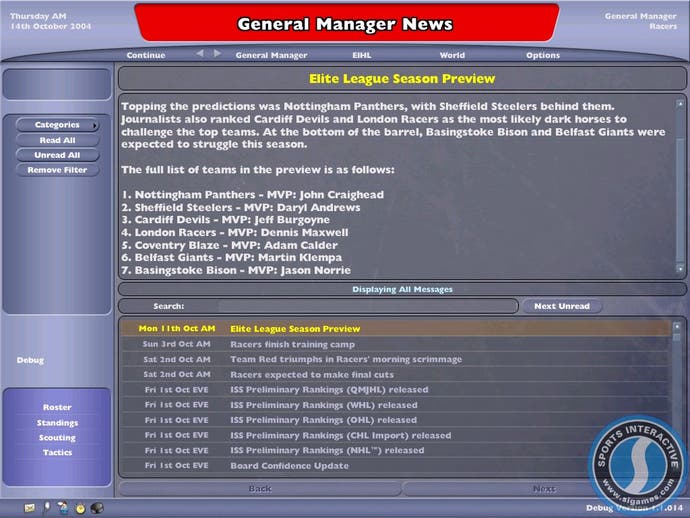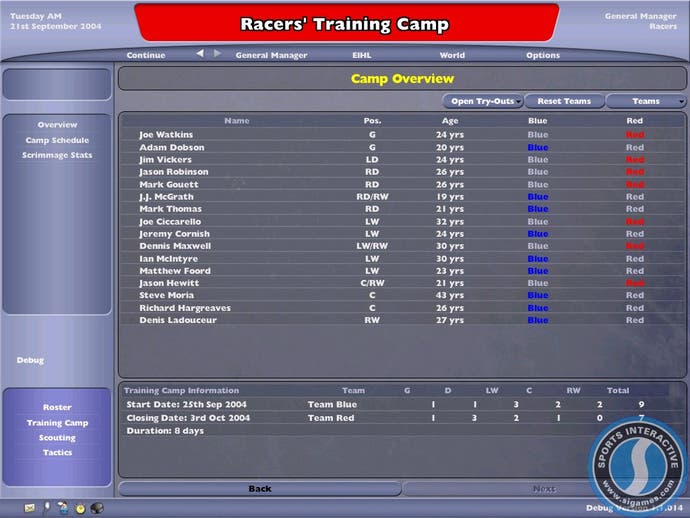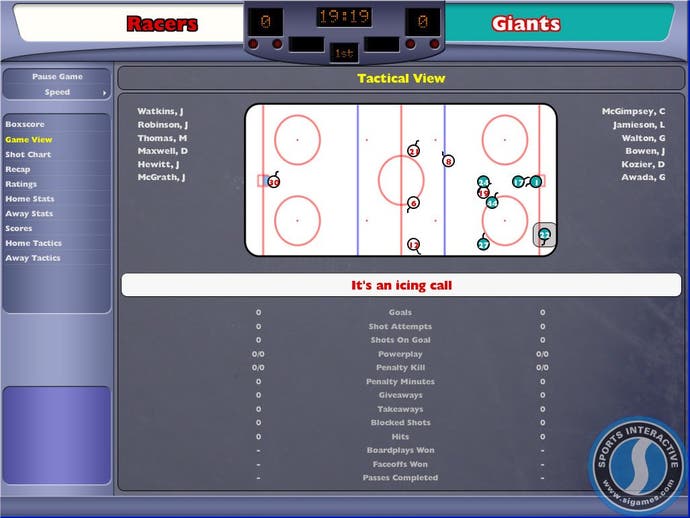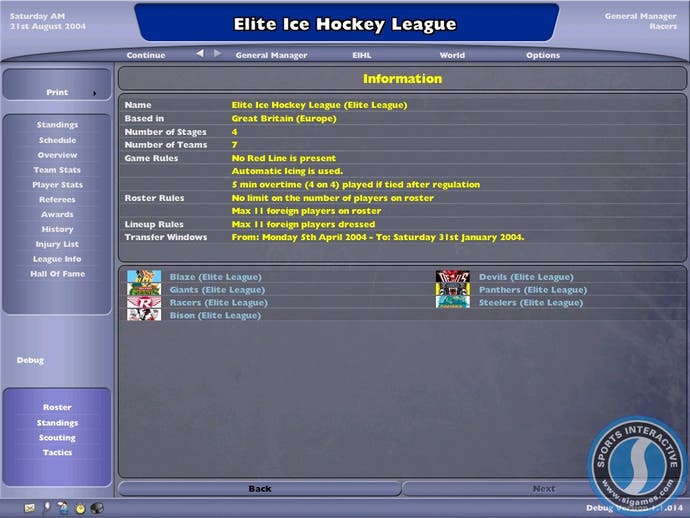NHL Eastside Hockey Manager 2005
Sports Interactive's Miles Jacobson and Risto Remes rink-le our brows with a comprehensive rundown of this year's hockey management sim.

"It's interesting," says Miles Jacobson, Sports Interactive managing director, butting into our conversation. "In the Scottish league they've got the first team and the under-19 team, but you're actually allowed to play two overage players in the under-19 team to get them back to full fitness." Blink.
Sports Interactive is synonymous with football. Football Manager is the company's bread and butter. Half the team were fans before they joined up to develop it. But if there's one thing that the above comment demonstrates, it's that you don't get to be in SI's position without being fundamentally and meticulously in love with sport in general. Frankly, it wasn't quite the interesting detail it was billed as - but it's something you'd only know if you really cared. When columnists talk about debates over rule changes and managers slagging off referees, it's easy to imagine said debates occurring around SI's water cooler, whatever the sport. Or at least around the Red Bull fridge.
So it wasn't too surprising to find myself in a room last week with no less than four senior SI staffers chucking hockey-related anecdotes and quips back and forth as I prayed my recorder was working and soaked it all up. SI knows football, but SI clearly also knows hockey. And, with the success of the first Eastside Hockey Manager - adapted by Risto "Riz" Remes and team from his original shareware hockey management title - hockey's starting to know Sports Interactive. A number of the firm's army of researchers - who populate the game's exhaustive database of teams, players and coaching staff - are hockey players themselves, and the dev team has even had one Swedish pro hockey coach asking for tips on how to win the Swedish league in-game. If that wasn't enough, half the London Racers hockey side are demanding to be brought in to test the thing.
The level of knowledge is impressive. Which is a good thing, because ice hockey is a complex game to understand, let alone emulate. Before you get onto the ice you have to pick 22 players, then slot them into lines - different line-ups that draw upon different areas of the squad's talent pool to face certain situations - and then on the ice you have to worry about alternating those lines, adjusting player positions and, of course, scoring goals. Off the field you have to look at fitness, media reports, scouting reports, organise training camps, assess draft players, rotate players, help injured players rehabilitate - and that, pun-tastically enough, is just the tip of the iceberg.
Last year's EHM modelled much of this, but naturally for the first retail game in an existing series there was a lot Sports Interactive felt it could come back and improve. No matter - SI believes in organic growth and the long haul, as Champ and Football Manager fans know only too well. There was never any suggestion of giving up. Indeed, the team views the last version as the game that made the transition from shareware to retail, whereas this is the one where they get to have fun. "I think the first version of EHM was very much a case of looking at Championship Manager 3 and making a hockey version of CM3," Miles tells us. "Whereas this year because of the feedback we've had from the boards there's actually quite a lot of stuff in here that's pretty different to stuff that we've done in the football games. So it's getting its own identity with a Football Manager look." Riz concurs: "This year we've got into the stage where we can add all the stuff that makes the game more alive."

SI games have always looked mighty handsome on a fact sheet, but EHM 2005's move from the nascent stage into a full-fledged product means that we've got our work cut out keeping up. For a start, it's got more playable leagues (15), more teams (3,200) and more players and staff (32,000) than before, and that number could rise. Licensing all this stuff is a real minefield - with the dev team having had to strip some team names out of last year's edition at the 11th hour stage - but surprisingly they're all very upbeat about it, and Miles seems proud when he says that the game will have more licenses and more leagues than perhaps any sports game ever. The consumer may take it for granted, but it's crucial to believability and SI knows it. Hence even the hockey teams' local media outlets are mentioned for in-game news items. And this time players even have small biographies that update with new details like career milestones as they play. "The only problem we have with the licenses is that the trademark symbol is used more than the letter 'e'," Miles jokes.
In terms of new features, Riz led off by telling us about training camps. "Training camps are like the pre-season friendlies in football, but in hockey it's more of a get-together where all the players come to the training facilities, you invite some new players over to be evaluated, you invite some young kids to come over to see how they're doing..." Miles jokes: "It's a bit like when Leicester City went to La Manga and all got arrested. Except without the arrests."
Camps are set up at places away from the media spotlight of a team's home rink - for example, a university campus upstate for a top NHL team - but depending on the team's status it may well just be at the home rink. Either way, you know the detail will have been researched by SI. Camps can be either open or closed - closed means you're strictly in control of who shows up, which is probably all right if you just want to knock some sense into a few people, but being open creates possibilities. Open camps are literally open to anybody, and it can be beneficial. "With the London Racers this year, they had a Czech guy who just showed up at the camp as a walk-in. No one knew he was coming. He just showed up on the first day of the camp. And he pretty much made the team, and was the leading scorer for some time," says Riz. And of course you can invite players who you're keeping an eye on to come and try out - even if they're with somebody else at the time. Imagine that, Chelsea fans.
Once at the camp, it's up to you what people do, but Riz says that on the first day the players will get together and do some physical tests "to see who's been eating hot dogs all summer". Then you can set up special schedules for different players if, for example, a player needs to build up his strength. Then there are games to play within the team - with as many as four smaller teams duking it out depending on the size of your squad - as well as full-size friendly games. Then reports on the best players, and detailed stats feedback on pretty much everything else. The entire schedule for the camp is meticulously set up to emulate what goes on in real life. In fact, the model for the camp was a real-life schedule from one of the Canadian researchers, who also happens to play and coach in a Canadian junior league - the equivalent of our smaller football leagues like the Conference.
Scouting is another area that's seen intensive overhaul. "A lot of people who play management games want to build up teams, so scouting's very important to them," says Riz. "Especially in hockey, because NHL teams don't have their own youth systems. They rely solely on their scouts to find any talent out there, and then use the draft system to draft those players that they want." In EHM 2005 you can send scouts to more specific areas, and you can even have someone permanently stationed at a certain league or in a certain country so they'll do their rounds, send reports, take a week off, then do it again so you don't have to keep reassigning them. You can set the level of scouting, too, varying the amount of feedback you get (the difference between "This guy's good, this guy isn't" at one end, and an extensive report discussing potential roles, comparable players and various scouts' individual opinions at the other), and you can set up alerts, too. With these set, the scout will know, for example, only to email you immediately about five-star players. You can also filter by age - useful if you're playing in an age-restricted league, obviously - and even tell scouts to ignore players who are totally unattainable.

This of course all feeds neatly into the issue of transferring players around. For the uninitiated, ice hockey works on the basis of drafting and trades rather than big money transfers, which is why you don't hear much about tapping-up or whatever the term du jour is for inviting someone to come over and look at a contract offer. However much we Brits poke fun at the franchise-driven sports of America, ice hockey sets a pretty decent example. The difficulty is the huge number of leagues around the world that subscribe to slightly different ideologies. With EHM 2005 running so many playable leagues, players are going to be flying around the globe, so it's important that trading rules and restrictions are meticulously observed. Just talking to SI, it's clear they will be. Within minutes Miles is debating the advantages and disadvantages of drafting players instead of having youth policies and the financial implications of the transfer market, while Riz is talking about the individual rules of European leagues with Premiership football-style transfer windows. We're assured that each league's own rules on trading - and that includes the different leagues within different countries, not all of which agree on these issues - will be observed in EHM 2005.
If you'd like another "even" that demonstrates the attention to detail, consider two-way contracts. There's one chap playing for the London Racers, Riz tells us, who also plays for the Slough Jets. His two-way contract with the Racers means he can play for either depending on his schedule. This is just another thing that EHM knows about and makes sure it gets right.
Perhaps the most obvious of the changes to EHM this year, however, is the 2D Tactical View. Fans of SI's football games will be only too well aware that the tactical view - or match engine - can make a huge difference - giving life to the reams and reams of commentary text. EHM 2005's is only a first step, and doesn't match Football Manager's for sheer depth of detail - updating only once per second, rather than nine times - but it certainly does more than just "give you the flow of the game," as Riz modestly puts it. It's a top-down view of the rink, and not only does it show you where on the ice all the shots were taken from, marking each with the number of the player who took the shot and highlighting those that went in with a different colour, but it also features a little net graphic that shows you where on the goal the puck went.
From the match screen you can look at an individual player's array of shots and view the shots period by period, and player positioning on the ice rink graphic is apparently accurate to within five feet of what's being computed. Alongside the 2D view the commentary goes on, but you can instruct the game to only show you key highlights - the goals, penalties, key saves and scoring chances, for example - or perhaps only get involved with tactical decisions between periods. You can even play through it in a couple of blinks if you're really impatient. The meticulous hockey fan, however, can do the opposite. With so much attention to detail, you can use these screens to really pick out what's happening. At one point in our demonstration a shot went in from quite far out, and one of our assembled onlookers asked how it happened. Riz looked at the screen and quickly worked out that the shot had come directly after a face-off and that there were a couple of players blocking the goalie's view. That's how.
You can pick out who's having a bad game player by player, tracing key incidents back to the cause - realising that a goal only came about because a player missed a body check in the corner, for example. And every key event gets a decent description. At one point in a demo game, Racers player Jeremy Cornish - a man who Miles insists is 17 feet tall - was sent off, and we were able to examine each infringement, right down to the note that Cornish concluded the battle by pulling the other guy's jersey over his head.

From the match screen you can also react and influence the outcome. In a situation that demands a goal, for example, you could instruct the coach to only play the top two attacking-focused lines (rather than the more defensive lines, or those for wearing down opponents), you can tell them to stick to the final third instead of dropping back to cover, you can tell them to shoot from anywhere, and if you're really desperate you can even pull your goalie off the pitch and add another outfielder. If you can keep possession with your one-man advantage, it can make all the difference.
What's doubly impressive, away from the Tactical View, is that the fine details of each encounter are preserved by your save game file. It does depend on how many leagues you have running simultaneously, but Riz says, "If you have two leagues running, when you get to the end of the season you can go back to the beginning and still see the reports for the first games." A tremendous amount of data considering that teams can play up to 82 games in a year.
Whether you're a hockey fan or not, it's pretty awe-inspiring stuff. SI has made its name by being meticulous fans of the sports it follows, not to mention meticulous about their game design - EHM 2005 is even colourblind-friendly - and its fondness for the communities that build up around its games means that a lot of the things reviewers and forum critics have been talking about are being addressed. Riz says he's given more financial control to the player, so you're unlikely to find that mismanaged wage caps lead to a board behaving intractably over the future of a particular player, and has borrowed Football Manager's salary breakdown feature. Meanwhile Miles is keen to address the issue of editing and customisation, something that a number of people have mentioned. "It's going to be skinnable straight away," he says. "There will be a data editor at some point too, but it probably won't be an official one. It's a time issue really. We've actually already had two guys from the community offer to do a data editor and they will be given the data format sometime before release. They'll be able to start working on that editor as soon as they've got that build. And they'll be helped a lot by us."
The team's attitude about most things is supportive - as evidenced by the amount of game elements, including the interface, that have called upon members of other SI dev teams, including the Out Of The Park Baseball team, lest we forget. At one point during our demonstration session, Riz tells Miles that someone he knows is already making a skin for the game. "If it's done in time it can go in the box," he replies.
Even without an official in-the-box data editor you can customise the rinks, the sound effects - you can even put in a custom horn sound for when your team scores at home. "Some of this stuff was in the last one but we didn't actually do a guide at any point on how to put it in and that's one of the things that we will be doing this time around so that people can customise the sounds and the graphics and put their own picture in there, and put their own name in there if they want to, and change the logos of the clubs and so on. So all of that stuff will be possible. The editing of data will also be possible, but it won't be an official SI thing," he adds.

NHL Eastside Hockey Manager 2005 is undoubtedly a game made by hockey fans for hockey fans. But the enthusiasm is infectious - and the ability to delegate more than before will be useful here, as newcomers hand off various tasks to the coach and other assistants without sacrificing total control. Indeed, you can even mix and match a bit, telling your coach to pick the players for each line but insisting that your favourite man be a key component of both attacking lines.
In time, perhaps those delegating will take full control and fall as much in love with the game as Riz - a man who spends so much time watching and reading about hockey and playing his own game that he's thinking about adding a hotkey function for Backspace that emulates the "Back" button on his Internet browser, so that the lines between truth and fiction are blurred even further.
Whether or not he does that, though, SI's obvious love of hockey and Eastside Hockey Manager seems to be giving it the level of realism SI's fans expect. The Racers' Jeremy Cornish, as a fan of the game, would probably agree, but actions speak louder than words. His sending off in our demo game was followed soon after by Miles' admission that he feared for his skin after Cornish found out he'd asked for a No. 11 shirt - Cornish's number - and come stomping around the office looking for him. Hopefully he won't mind Miles' telling us about it, eh?
In any case, the new and improved NHL EHM 2005 will be out this summer. Assuming Miles survives.

